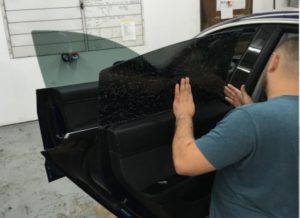Ceramic Window Film Protects Your Car From Heat and UV Rays
Boost comfort, protect your belongings, and reduce UV rays with state-of-the-art ceramic window tint! This tint also offers glare control and doesn’t interfere with GPS and cell phone signals.
It’s made without dyes or metal, allowing it to block 99% of harmful UV rays and reject both infrared and solar energy. Plus, it’s color stable and won’t fade.
Reduces Solar Heat
Many types of window film absorb the solar spectrum to reduce heat gain. However, they only reduce a fraction of the infrared portion. This allows a large amount of unwanted heat to enter your car.
allows a large amount of unwanted heat to enter your car.
Ceramic window tint blocks infrared energy while allowing visible light to pass through the windows. It also keeps interiors cool and comfortable while reducing glare.
Window tint helps protect interior from sun damage, color fading and deterioration. It can also help prevent skin cancer by blocking harmful UV rays that can cause burning and discoloration.
Ceramic window films such as XPEL PRIME XR PLUS feature a premium nano-ceramic formula. This technology combines carbon and graphene to block 98% of infrared heat and 99% of damaging UV rays. This advanced film is corrosion resistant and backed by a limited lifetime transferable warranty.
Blocks UV Rays
The nonmetallic nano-particles in ceramic tint help to block 99% of the UV rays that penetrate windows. This helps to protect your skin from sun damage and wrinkling. It also reduces the risk of skin cancer, including basal cell carcinoma, squamous cell carcinoma and melanoma.
XPEL PRIME XR PLUS high-performance ceramic window film does all of this and more. It is available in a range of VLT or visible light transmission ratings and includes a limited lifetime transferable warranty.
Its patented ceramic oxide particle formula delivers superior heat rejection, UV blocking and glare control. And, unlike metalized films, it doesn’t interfere with GPS, cell signal or radio waves. It is also a sleek, dark choice with a matte finish that won’t fade like dyed tints do.
Shatter-Proof
In addition to blocking UV rays, ceramic window film is also shatter-proof, which can significantly reduce the amount of glass fragments in your windows after an accident or natural disaster. This helps reduce the risk of physical harm or property damage, while also protecting your employees, data and customers.
Ceramic tint doesn’t contain metal, dye or carbon, but instead uses ceramic particles that are both non-conductive and invisible to the naked eye. This gives it a crystal-clear appearance and excellent performance when it comes to UV protection, infrared light rejection and sun glare reduction.
LLumar and Eastman’s ceramic window tint options offer strong heat rejection and reduced UV rays, with a clear appearance that will upgrade your vehicle’s looks. They look great on cars and trucks, and are less likely to peel or fade over time than carbon or dyed films.
Long-Lasting
Infrared rays are what make the car feel hot, and ceramic window tint absorbs this energy to reduce the amount of heat coming through your windows. As an alternative to metalized and carbon films, this option offers superior IR rejection without sacrificing clarity or visibility.
It is also scratch-resistant and more durable than dyed or metallic films, making it harder for someone to break into your vehicle. Additionally, it provides added privacy while protecting your valuables and minimizing fading and color deterioration.
Solar Gard’s established VortexIR ceramic series features a dark, matte finish and is designed to be less reflective than traditional tints. It is available in a variety of VLT percentages, so you can choose how much light you want to let in. The latest offering from the brand, XenithIR, boasts more glare reduction and improved UV protection.
Affordable
Ceramic window tint has a higher price point than other films, but it offers the best protection against UV rays. It also leads to a cooler car interior, reduces glare and is long-lasting.
The main difference between ceramic and other types of window film is that ceramic has no metal particles. Therefore, it doesn’t interfere with Wi-Fi connectivity and cell phone service as metallic window tint can.
Other types of window tint include dyed polyester, which uses a liquid dye to create different levels of “tint.” This type of tint tends to fade over time. However, it is an affordable option for people looking for privacy and UV protection. It does not prevent heat from entering, but it blocks out UV rays and helps deter theft.

